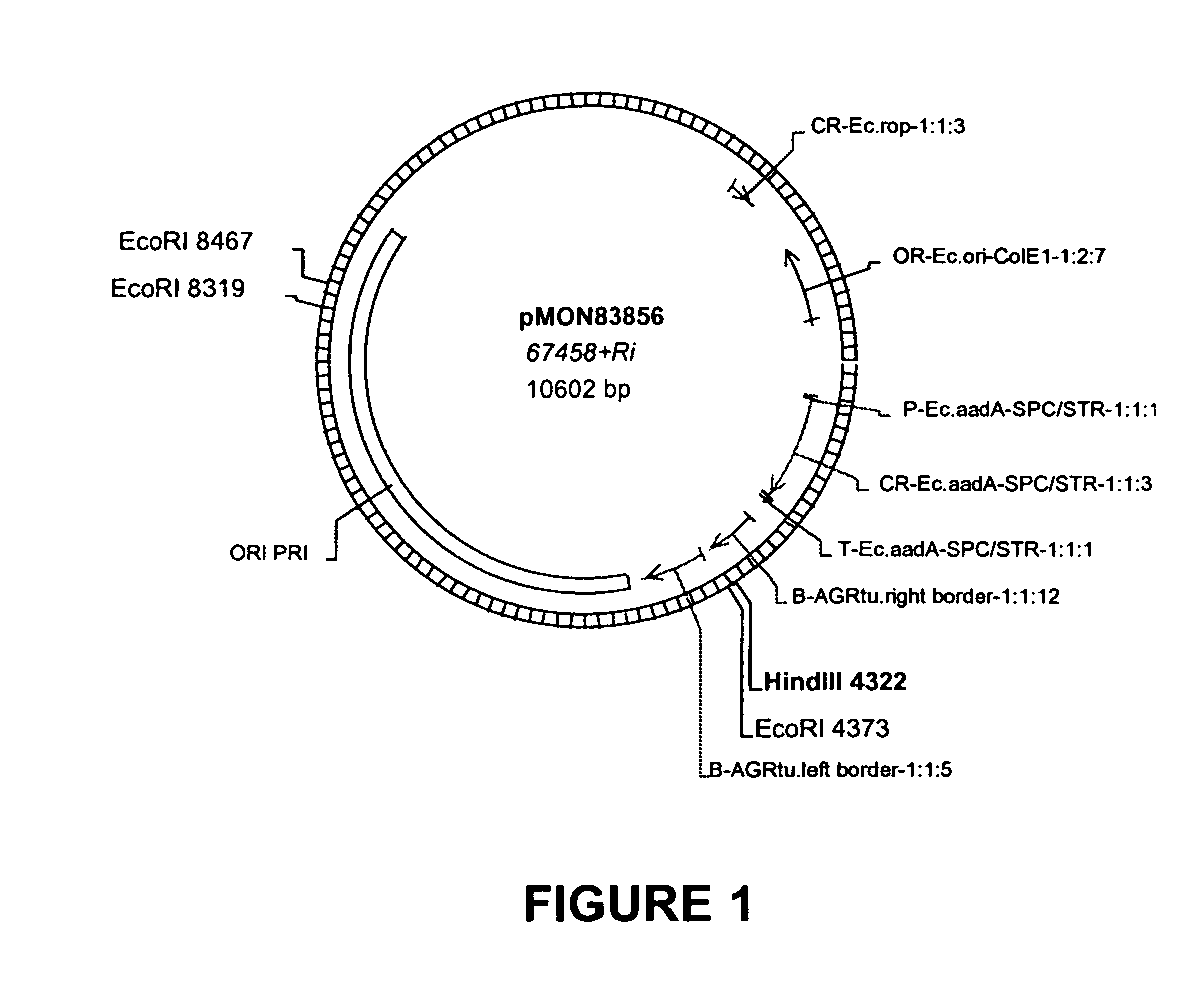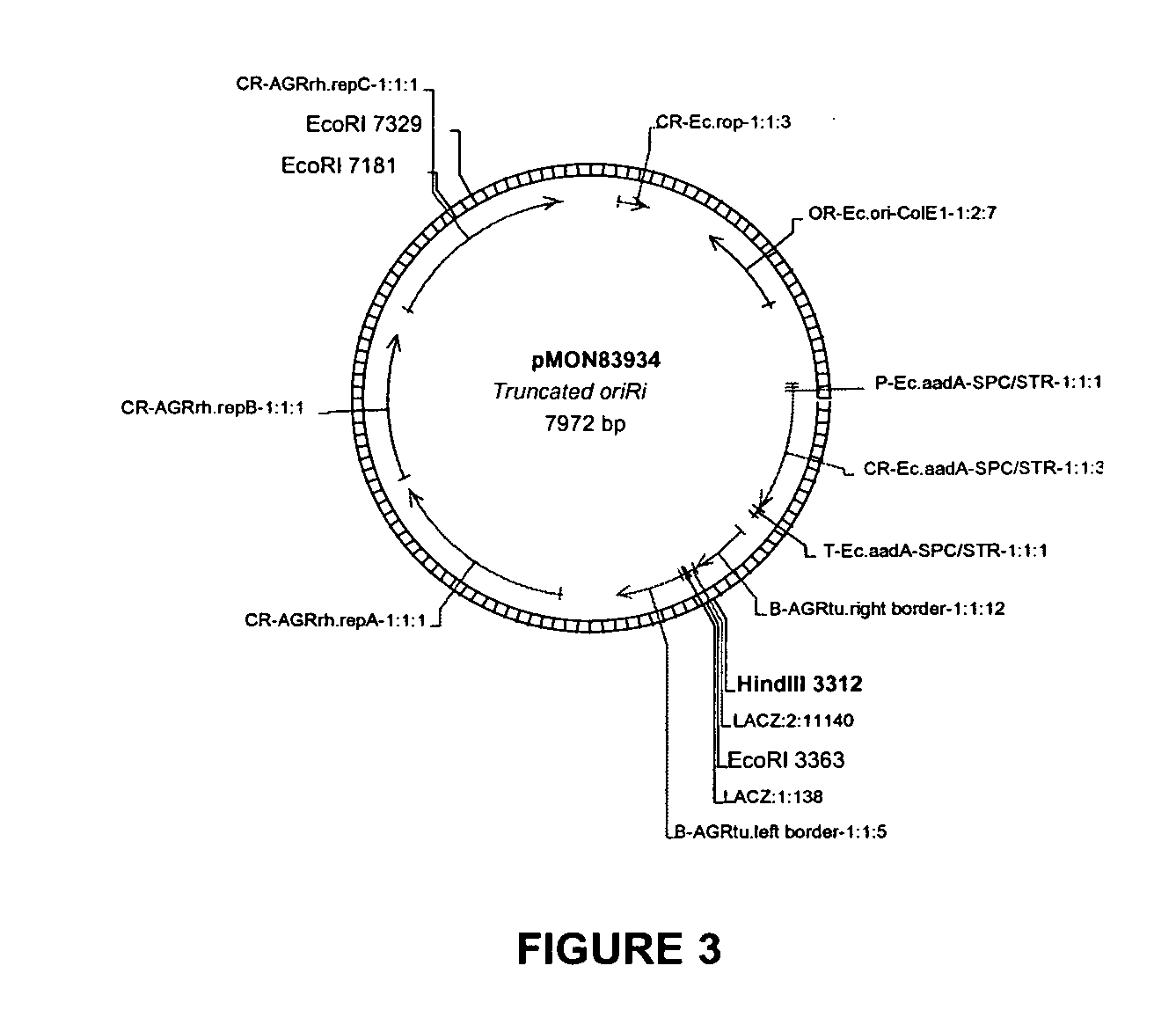Vectors and methods for improved plant transformation efficiency
a plant and vector technology, applied in the field of molecular biology, can solve the problems of time-consuming and expensive methods for large-scale screening work, and transgenic plants containing more than two transgenes are usually of little value for commercial development, so as to improve the quality of events, reduce the frequency of vector backbone dna, and increase the frequency of t-dna transformation events
- Summary
- Abstract
- Description
- Claims
- Application Information
AI Technical Summary
Benefits of technology
Problems solved by technology
Method used
Image
Examples
example 1
Preparation of Vectors
[0062] Cloning steps followed standard protocols described by Sambrook et al. (1989). The 5.6 kb oriRi fragment, excised from pCGN1589 with DraI digestion, was used to replace the oriV fragment of pMON67438 that was digested with PshAI and BstXI and blunted with T4 DNA polymerase. This resulted in an oriRi base vector pMON83856 (FIG. 1). The 5.6 kb oriRi testing vector pMON83882 (FIG. 2) was made by insertion of the gus and CP4 fragments from the oriV control vector pMON67438, sequentially digested with AccI (blunted) / BamHI, into pMON83856 that had been opened with PmeI / BamHI. To truncate the oriRi fragment, two primers, 5′ CACGTGTACAAGGTAGAATCCGCCTGAG 3′ (oriRi 5′ promoter upstream; SEQ ID NO:5) and 5′ GTATACAGGCTCTCCTTCACGATCAAC 3′ (oriRi 3′ after repC: SEQ ID NO:6), were synthesized and PCR was performed with high fidelity pfu polymerase and pMON83856 as a template. The PCR product was purified and inserted into pMON83930, which was digested with AfeI and X...
example 2
Soybean Crop Transformation
[0065] Transformation of soybean cells and regeneration of the cells into intact fertile plants by Agrobacterium-mediated transformation can be conducted using various methods known in the art. A method for soybean transformation (e.g. U.S. Pat. Nos. 6,384,301 and 7,002,058) was utilized with an organogenesis process.
[0066] The DNA constructs described in the present invention (e.g., plasmid pMON83882, substantially as shown in FIG. 2, and plasmid pMON83937, substantially as shown in FIG. 4) are transformed into a disarmed Agrobacterium strain ABI. The two oriV control vectors, pMON67438 and pMON83898 (same GOI but in different orientations), were also transferred into Agrobacterium cells. Two T DNA constructs and respective controls as described above were also used for transforming soybean. The DNA construct was transferred into Agrobacterium by electroporation. Single colonies were recovered on LB medium with spectinomycin 50 mg / l (for oriRi vectors) ...
example 3
Corn Crop Transformation
[0071] Two vectors, pMON97352 (oriRi, single copy in Agrobacterium) and pMON92726 (oriV, multiple copies in Agrobacterium as a control) containing same plant selectable marker gene CP4 and gus gene cassettes, both driven by rice actin promoters (FIG. 5), were electroporated into Agrobacterium tumefaciens strain ABI for corn transformation. Agrobacterium containing the vector in glycerol stock was streaked out on solid LB medium supplemented with antibiotics (all in active ingredient) kanamycin (40 mg / L), spectinomycin (31 mg / L), streptomycin (38 mg / L) and chloramphenicol (25 mg / L) and incubated at 28° C. for 2 days. Two days before Agrobacterium inoculation of the maize immature embryos, one colony or a small loop of Agrobacterium from the Agrobacterium plate was picked up and inoculated into 25 mL of liquid LB medium supplemented with 62 mg / L of spectinomycin and 40 mg / L of kanamycin in a 250 mL flask. The flask was placed on a shaker at approximately 150-2...
PUM
| Property | Measurement | Unit |
|---|---|---|
| temperature | aaaaa | aaaaa |
| temperature | aaaaa | aaaaa |
| temperature | aaaaa | aaaaa |
Abstract
Description
Claims
Application Information
 Login to View More
Login to View More - R&D
- Intellectual Property
- Life Sciences
- Materials
- Tech Scout
- Unparalleled Data Quality
- Higher Quality Content
- 60% Fewer Hallucinations
Browse by: Latest US Patents, China's latest patents, Technical Efficacy Thesaurus, Application Domain, Technology Topic, Popular Technical Reports.
© 2025 PatSnap. All rights reserved.Legal|Privacy policy|Modern Slavery Act Transparency Statement|Sitemap|About US| Contact US: help@patsnap.com



